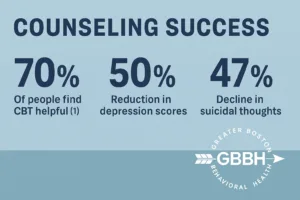Some people don’t scream. They don’t cry for help or send frantic texts.
Instead, they just… stop.
They go to work. They answer “I’m fine.”
And quietly, they start to wonder if not waking up tomorrow might feel like relief.
This story is for those people.
And it’s about one client at Greater Boston Behavioral Health who didn’t want to die—but didn’t want to keep living like this either. Until CBT gave them a reason to stay.
“I Don’t Want to Die. I Just Don’t Want to Live Like This.”
They didn’t come into therapy with a dramatic breakdown. There was no crisis, no ER visit, no intervention.
What brought them to us was something softer—but just as serious.
They said:
“I don’t want to die. I just don’t see the point anymore.”
They’d been holding it together for a long time. Smiling. Working. Answering messages.
But underneath? A constant ache. The quiet thought: Maybe this is just how life is now. Empty. Unfixable.
They weren’t looking for a miracle.
They just wanted one moment to feel bearable again.
CBT Gave Them Something Solid to Stand On
Cognitive behavioral therapy (CBT) didn’t promise to fix them.
That mattered. Because part of them was tired of being “worked on.”
CBT did something gentler:
It gave language to their pain. It made invisible thoughts visible.
They learned that depression wasn’t a personal failure.
It was a pattern. A loop of thoughts, behaviors, and beliefs that could—slowly—be interrupted.
With a therapist trained in CBT, they began to explore the connections between:
- What they were thinking (“I’m worthless.”)
- What they were feeling (numb, hollow)
- And how they were behaving (withdrawing, overworking, shutting down)
CBT didn’t try to cheer them up.
It helped them see.
The First Shift Wasn’t Hope—It Was Clarity
There’s a moment in CBT that often feels like a turning point—not because everything feels better, but because something finally makes sense.
For them, it was realizing that their thoughts were not facts.
They’d spent so long believing the voice in their head:
“You’re a burden.”
“Nothing you do matters.”
“You’re too much—and not enough.”
CBT helped them pause and ask:
Is this true? Or is this pain talking?
That question changed everything.
Because even if they didn’t believe in hope yet—they could believe in curiosity.
And curiosity is where healing starts.
A Week Without a Spiral Was a Victory
Their therapist didn’t push positivity. Instead, they built rituals.
Small things that offered a thread of consistency:
- Writing down one distorted thought per day—and responding to it with evidence
- Naming three neutral things (not “good,” just okay) from the day before
- Scheduling one low-effort task that felt achievable—like taking a different walking route or brewing their favorite tea
Some weeks were still heavy. Some days felt unbearable.
But over time, the spirals slowed.
Instead of “I messed up that meeting—I’m useless,” they could say:“That meeting was rough. But I’ve handled worse. And it doesn’t define me.”
That reframe didn’t erase the pain. But it softened it.
And sometimes softening is enough to stay.
They Started Wanting Things Again
This is the part no one warns you about:
When you start healing, you start wanting.
And wanting feels terrifying at first—because it means imagining a future again.
At first, it was small things.
They bought a plant and actually watered it.
They texted a friend and made plans they didn’t cancel.
They noticed when the air smelled like fall and it made them feel something.
CBT didn’t fix them. It made space for them to feel again.
And that was everything.
Healing Isn’t Linear—But It Is Possible
Not every session felt like a breakthrough. Some days, they didn’t want to talk.
Some days, they resented the hope their therapist had for them.
But the space remained steady.
Their therapist wasn’t scared off by silence. Or sarcasm. Or bad days.
That steadiness built trust.
And trust turned into momentum.
Months later, they looked back and realized:
They no longer felt like they were surviving every day. They were living some of them.
If You’re Feeling This Way, CBT Might Be a Place to Start
You don’t need to be in crisis to get help.
You don’t need to “prove” how bad it is.
If you’re exhausted, numb, or secretly hoping you just disappear—that’s reason enough.
CBT can offer structure when everything feels chaotic.
It can help you see yourself—and your life—through a lens that isn’t tinted by despair.
Most importantly, it offers a place where your pain isn’t dismissed—and your existence isn’t questioned.
You don’t have to want to be alive right now.
You just have to stay curious enough to wonder what else might be possible.
FAQ: CBT for Suicidal Thoughts
Is CBT safe for people with suicidal ideation?
Yes—CBT is one of the most evidence-based approaches for people experiencing suicidal thoughts. It’s designed to help people recognize, question, and reframe the negative thought patterns that contribute to hopelessness and emotional pain.
Will a therapist report me if I mention suicidal thoughts?
Therapists take suicidal ideation seriously—but not every mention of suicidal thoughts leads to hospitalization. If you are not actively planning or intending to harm yourself, your therapist can work with you to explore those thoughts safely. Honesty builds trust.
How is CBT different from “talk therapy”?
CBT is more structured than traditional talk therapy. It focuses on identifying thought patterns and behaviors that reinforce depression or anxiety and teaches you how to shift them. It often includes exercises, journaling, or worksheets to support this process.
How long does CBT take to work?
Some people notice a shift after just a few sessions—especially in awareness of patterns. Lasting change often takes a few months. The pace is always tailored to you.
Do I have to talk about everything in my past?
No. CBT focuses more on the present—your current thoughts, behaviors, and patterns. While your past may come up, it’s not the focus unless you want it to be.
You Don’t Have to Carry This Alone
If you’re reading this and it feels too close to home—please know that silence doesn’t have to be your only option.
At Greater Boston Behavioral Health, we offer CBT that meets you where you are—not with pressure, but with presence.
Call (888) 450-3097 or visit our CBT services page in Boston, Massachusetts to learn how CBT can help you find stability, clarity, and maybe—one day—hope again. And for those in Needham, Newton, or West Roxbury, we have nearby locations to make care accessible.


